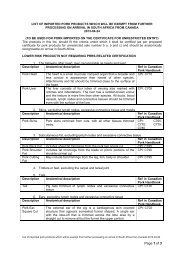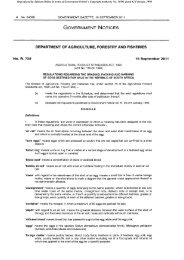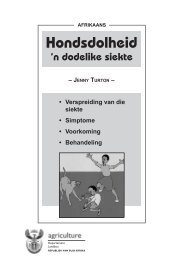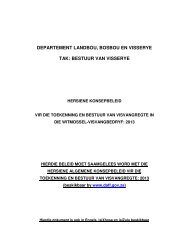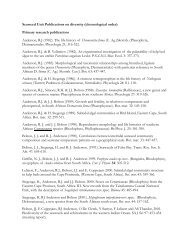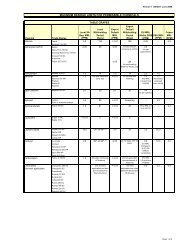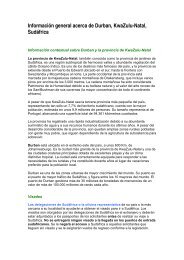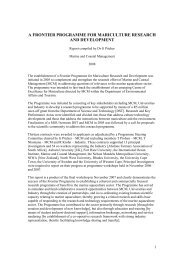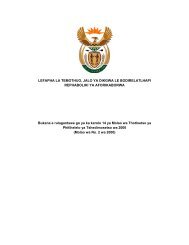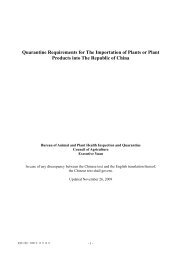You also want an ePaper? Increase the reach of your titles
YUMPU automatically turns print PDFs into web optimized ePapers that Google loves.
T<br />
he Gastropoda is a large class of snails and<br />
slugs that belongs to the phylum Mollusca.<br />
There are over 35 000 species of gastropods. Most<br />
of them are snails with a spiral shell but some, like<br />
the limpets, have cap-shaped shells and others are<br />
slugs that lack shells. All gastropods have a head<br />
with sensory tentacles and eyes. They have a large<br />
foot on top of which is a mass of body organs<br />
including a gut, reproductive organs, the blood<br />
system, heart and kidney, hence their scientific<br />
name 'Gastropoda,' which means 'gut-footed'.<br />
This visceral mass is twisted into a spire during at<br />
least some stage of the life cycle of gastropods. The<br />
gastropods can be divided into three subclasses,<br />
which are described below.<br />
Reproduction and life cycle<br />
The primitive gastropods shed their eggs and sperm into the<br />
w a t e r. After fertilisation the eggs develop into tro c h o p h o re larvae,<br />
which swim through the water, like a spinning top, propelled by<br />
a ring of hairs around their middle regions. The trochophore<br />
larvae metamorphose into veliger larvae that have two expanded<br />
frontal lobes (the velum) which are fringed with cilia that flicker<br />
to drive the larvae forward. As it ages the veliger develops a<br />
shell and then twists, so that instead of backing into the shell<br />
leaving the head vulnerable, it can retreat head first into the<br />
shell and use its tough foot to close the shell. This process is<br />
called 'torsion'. The result is that the gill cavity comes to lie<br />
over the head of the snail. Some of the more advanced gas-<br />
tropods, such as the whelks, practise internal fertilisation and<br />
lay eggs in capsules in which the eggs develop into miniature<br />
adults; there is no planktonic larval stage. In a few species<br />
the eggs are retained in the egg duct until they hatch.<br />
Subclass Prosobranchia<br />
– abalones, limpets, winkles and whelks<br />
This group includes the vast majority of marine gastropods.<br />
Prosobranch means 'front gill', referring to the placement of<br />
the mantle cavity with the gills above the head due to the 180º<br />
rotation of the animal within its shell during larval development<br />
(torsion). The group includes the herbivorous limpets, abalones<br />
and winkles and the more advanced carnivores such as<br />
whelks and cones. The herbivorous snails, such as limpets<br />
and winkles, scrape the rocks and rasp seaweed with their<br />
radulas (a 'tongue' bearing rows of teeth). The radula may be<br />
twice as long as the body of the snail and is continually<br />
C O A S TA L A N D M A R I N E L I F E – A N I M A L S : I N V E RT E B R A T E S – M O L L U S C S<br />
Gastropods 3B<br />
replaced as it is worn away in front. In the very long, coiled<br />
gut, the seaweed is sorted and digested. Carnivorous gastro-<br />
pods (whelks) have a much shorter gut because the food is<br />
softer and more easily digested. The radula is shorter and<br />
may be specialised to drill through the shells of prey or even<br />
modified into harpoons to stab the prey, as is the case in the<br />
cone shells. The scavengers and carnivorous shells have an<br />
oval opening to the shell through which a tube, the siphon is<br />
extended. This is used to draw water into the shell to aerate<br />
the gills and to taste the water for traces of food.<br />
<strong>Abalone</strong> These ear-shaped shells graze on<br />
seaweed and have a row of holes through<br />
which water flows after aerating the gills,<br />
and washes away the faeces and eggs.<br />
Limpets Shallow, conical shells<br />
characterise all limpets. Each limpet has<br />
a home scar where its shell grows to fit<br />
the shape of the rock and this pro-<br />
tects it from predators, wave action<br />
and desiccation.<br />
South Africa has more species of limpets<br />
than anywhere else in the world. Each species<br />
is specialised for a particular habitat and some, such<br />
as the pear limpet, even form unique zones on the shore<br />
where they can occur in densities of over 2000 to a square<br />
metre. Some are quick-growing general feeders that scrape<br />
food from the rocks or trap drift algae. Others are slow-gro w i n g<br />
gardeners that start life on the backs of other shells and then<br />
move down onto their own home territories where they guard,<br />
fertilise and graze a garden of a special seaweed. They can<br />
reach an age of over 20 years. The low-shore Argenville’s<br />
limpet traps kelp that washes under its raised shell. The kelp<br />
limpet's shell is oval and curved to fit the kelp stipe, on which<br />
it lives and feed.<br />
Winkles are herbivores 'Winkle' is a common name for a<br />
large group of snails whose coiled shells have a circular mouth<br />
(without a groove), that is blocked by a ‘door’ (operculum) when<br />
the animal withdraws into the shell. Most winkles have low-<br />
spiralled shells. They are herbivorous, using a rasping radula<br />
to feed on seaweed and juvenile plants. The large round giant<br />
periwinkle has a characteristic knobbled, calcified o p e rc u l u m .<br />
It has been heavily exploited along the<br />
c o a s t . Topshells are abundant in the<br />
intertidal and have a horny, flexible<br />
operculum. The small periwinkles<br />
(littorinids) form a zone at the<br />
highest level on the rocky shore.<br />
They are very hardy and able to live<br />
out of water for several days.<br />
Venus ear shell<br />
Giant periwinkle, Alikreukel<br />
Long-<br />
spined<br />
limpet





